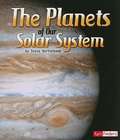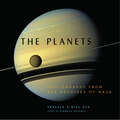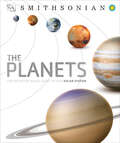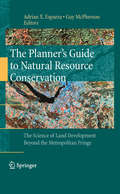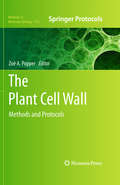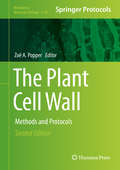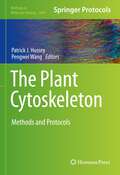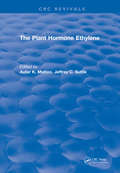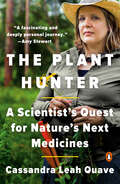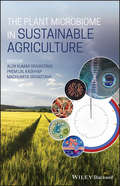- Table View
- List View
The Planet Remade
by Oliver MortonThe risks of global warming are pressing and potentially vast. The difficulty of doing without fossil fuels is daunting, possibly even insurmountable. So there is an urgent need to rethink our responses to the crisis. To meet that need, a small but increasingly influential group of scientists is exploring proposals for planned human intervention in the climate system: a stratospheric veil against the sun, the cultivation of photosynthetic plankton, fleets of unmanned ships seeding the clouds. These are the technologies of geoengineering--and as Oliver Morton argues in this visionary book, it would be as irresponsible to ignore them as it would be foolish to see them as a simple solution to the problem. The Planet Remade explores the history, politics, and cutting-edge science of geoengineering. Morton weighs both the promise and perils of these controversial strategies and puts them in the broadest possible context. The past century's changes to the planet--to the clouds and the soils, to the winds and the seas, to the great cycles of nitrogen and carbon--have been far more profound than most of us realize. Appreciating those changes clarifies not just the scale of what needs to be done about global warming, but also our relationship to nature. Climate change is not just one of the twenty-first century's defining political challenges. Morton untangles the implications of our failure to meet the challenge of climate change and reintroduces the hope that we might. He addresses the deep fear that comes with seeing humans as a force of nature, and asks what it might mean--and what it might require of us--to try and use that force for good.
The Planets
by Dava SobelA rich exploration of our solar system--what we know, what we wonder, what we believe.
The Planets
by Dava SobelAfter the huge national and international success of LONGITUDE and GALILEO'S DAUGHTER, Dava Sobel tells the human story of the nine planets of our solar system. This groundbreaking new work traces the lives of each member of our solar family, from myth and history, astrology and science fiction, to the latest data from the modern era's robotic space probes. Whether revealing what hides behind Venus's cocoon of acid clouds, describing Neptune's 'complex beauty in subtle stripes and spots of royal to navy blue, azure, turquoise, and aquamarine', or capturing first-hand the excitement at the Jet Propulsion Laboratory when the first pictures from Cassini at Saturn were recently beamed to earth, Dava Sobel's unique tour of the solar system is filled with fascination and beauty. In lyrical prose interspersed with poems by Tennyson, Blake and others, The Planets gives a breathtaking, intimate view of those heavenly bodies that have captured the imagination since humanity's first glimpse of the glittering night skies. This extraordinary book of science, history, biography and storytelling will engage and delight. It is at once timely and timeless, and of infinite relevance to this age in which new planets are being discovered elsewhere in our galaxy, around stars other than the Sun.
The Planets
by Gail Gibbons<p>A nonfiction favorite for more than twenty years, The Planets has been updated to include some of the latest discoveries in space exploration. <p>From the burning surface of Venus to the freezing darkness of Neptune, Gail Gibbons takes children on a tour of our planetary neighbors—which are very different from each other in size, shape, orbit, and even weather. <p>Since its original publication in 1993, The Planets has been a home and classroom staple for introducing our solar system to the youngest readers. With her signature blend of clear, bright illustrations and accessible text, Gail Gibbons takes readers on a tour of our planetary neighbors, near and far. <p>From the burning surface of Venus to the freezing darkness of Neptune, the bodies in our solar system are named, described, and illustrated in clear, well-labeled spreads that give a strong sense of shape and scale to our skies. Each entry is full of intriguing details about their composition, behavior, and moons.</p>
The Planets (Fifth Edition)
by Gail GibbonsA new edition of a nonfiction favorite for more than 20 years from science writer Gail Gibbons, updated with the latest discoveries in space exploration.From the burning surface of Venus to the freezing darkness of Neptune, Gail Gibbons takes children on a tour of our solar system—which are very different from each other in size, shape, orbit, and even weather. Since its original publication in 1993, The Planets has been a home and classroom staple for introducing our solar system to the youngest readers. With her signature blend of clear, bright illustrations and accessible text, Gail Gibbons takes readers on a tour of our planetary neighbors, near and far.This updated edition brings the latest scientific understanding of the planets of our solar system to young readers. The bodies in our solar system are named, described, and illustrated in clear, well-labeled spreads that give a strong sense of shape and scale to our skies. Each entry is full of intriguing details about their composition, behavior, and moons.
The Planets in Our Solar System
by Franklyn M. BranleyYou live on Earth, so you already know a lot about it. But do you know about its place in out solar system? For instance, it's not the largest planet. If Jupiter were a hallow ball, 1,000 Earths would fit inside it. And did you know our planet Earth takes 365 days to go around the sun, while the planet Pluto takes 248 years? This simple text by Franklyn M. Branely introduces the nine planets in our solar system and is complemented by Kevin O'Malley's full-color illustrations, which incorporate some of the newest space photographs available. How hot is it on Venus? Which planet takes longest to orbit the sun? Find out the answers in this updated version of this popular text. Kevin OMalleys often humorous illustrations depict a group of children and an astronomer as they learn all about our solar system. Included are some of the newest space photographs available, as well as many hands-on activities.
The Planets of Our Solar System
by Steve KortenkampVenus is a sweltering, spinning rock. Jupiter is a huge ball of gas. But they are both planets. Get up-close to the eight planets that orbit around our solar system.
The Planets: Fourth Edition
by Gail GibbonsA nonfiction favorite for more than twenty years, The Planets has been updated to include some of the latest discoveries in space exploration. From the burning surface of Venus to the freezing darkness of Neptune, Gail Gibbons takes children on a tour of our planetary neighbors—which are very different from each other in size, shape, orbit, and even weather. Since its original publication in 1993, The Planets has been a home and classroom staple for introducing our solar system to the youngest readers. With her signature blend of clear, bright illustrations and accessible text, Gail Gibbons takes readers on a tour of our planetary neighbors, near and far. From the burning surface of Venus to the freezing darkness of Neptune, the bodies in our solar system are named, described, and illustrated in clear, well-labeled spreads that give a strong sense of shape and scale to our skies. Each entry is full of intriguing details about their composition, behavior, and moons.
The Planets: Photographs from the Archives of NASA
by Nirmala Nataraj“Might be just the book to bring out your inner astronomer . . . over 250 pages of breathtaking images from the past 50 years of NASA’s space exploration.” —ParadePreface by Bill NyeThis magnificent volume offers a rich visual tour of the planets in our solar system. More than two-hundred breathtaking photographs from the archives of NASA are paired with extended captions detailing the science behind some of our cosmic neighborhood’s most extraordinary phenomena. Images of newly discovered areas of Jupiter, fiery volcanoes on Venus, and many more reveal the astronomical marvels of space in engrossing detail. Anyone with an interest in science, astronomy, and the mysteries of the universe will delight in this awe-inspiring guide to the wonders of the solar system.“As you turn through the pages, you’re hit with true moments of awe, photos that remind you the power of nature extends beyond our own planet.” —Houston Chronicle“Breathtaking pictures show the otherworldly magic of the solar system . . . The images are at once humbling and uplifting: Here in the black void of space is Saturn’s frozen moon, Mimas, white and pitted like a galactic golf ball; here is the tiny golden orb called Io, casting a shadow in a perfect inky circle on the marbled surface of Jupiter; here is the great sun, flames spurting from its surface like plumes.” —The Wall Street Journal“[A] gorgeous photographic tour of space . . . The collection is a remarkable reminder of how much has been learned about the planets over the past few decades, solving many mysteries yet introducing many more.” —Publishers Weekly
The Planets: The Definitive Visual Guide to Our Solar System
by DKDiscover places where a day is longer than a year, where hailstones are made of diamonds, and where a mountain looms twice the size of Everest. These and more are all to be found in The Planets.The Sun&’s gravity holds in thrall eight planets, each with an entourage of moons, as well as dwarf planets, asteroids, and comets. The Planets takes you on a dazzling visual tour. From the Solar System&’s fiery heart, travel to rocky worlds such as tiny Mercury scorched by the Sun. Then witness Venus swathed in a sulfurous haze, and go to the outer reaches to visit planets such as gas giant Jupiter, which is 120 times the size of Earth.Using 3-D models and photography from NASA and the European Space Agency, The Planets describes each one, as well as the extraordinary endeavors of space exploration. Edited by space scientist Maggie Aderin-Pocock, this book is enthralling reading for everyone interested in astronomy and space exploration.
The Planner’s Guide to Natural Resource Conservation:
by Adrian X. Esparza Guy McphersonMuch of the country's recent population growth is situated in exurban areas. By many accounts exurbanization has become the dominant pattern of land development in the country and there is no indication it will slow in the foreseeable future (Theobald 2005; Brown et al. 2005; Glennon and Kretser 2005). By definition, exurban development takes place beyond the metropolitan fringe, often in rural and remote areas. The development of new exurban communities is a growing trend, especially in the West. In this case, developers and homebuilders seek large tracts of land, up to thousands of acres, in rural areas (typically within 50 miles of a large city) where they plan entire communities consisting of commercial, retail and residential land uses. Recreational amenities such as golf courses and hiking/biking trails are often included in these master-planned developments. Our philosophy is reflected in the book's two objectives. First, we seek to document the extent and impacts of exurban development across the country. At issue is demonstrating why planners and the public-at-large should be concerned about exurbanization. We will demonstrate that even though exurbanization favors amenity rich regions, it affects all areas of the country through the loss of agricultural and grazing lands, impacts to watersheds and land modification. A summary of environmental impacts is presented, including the loss of wildlands and agricultural productivity, land modification, soil erosion, impacts to terrestrial hydrologic systems, the loss of biodiversity, nonnative and endangered species and other topics. Our second aim is to provide readers from diverse (nonscientific) backgrounds with a working knowledge of how and why exurbanization impacts environmental systems. This is accomplished by working closely to ensure contributors follow a specific outline for each chapter. First, contributors will spell out fundamental concepts, principles and processes that apply to their area of expertise (e.g., riparian areas). Contributors will move beyond a cursory understanding of ecological processes without overwhelming readers with the dense material found typically in specialized texts. For this reason, visuals and other support materials will be integral to each chapter. We have chosen contributors carefully based on their record as research scientists and acumen as educators. Second, once the mechanics have been laid out, authors will explain how and why land development in nearby areas influences ecosystems. Issues of interdependency, modification and adaptation, spatial scale and varying time horizons will be featured. Third, contributors will weigh in on the pros and cons of various land-development schemes. Fourth, authors will share their thinking on the merits of conservation devices such as wildlife corridors, open-space requirements and watershed management districts. Finally, each chapter will conclude by identifying pitfalls to avoid and highlighting "best practices" that will mitigate environmental problems or avoid them altogether. In sum, after completing each chapter, readers should have a firm grasp of relevant concepts and processes, an understanding of current research and know how to apply science to land-use decisions.
The Plant Cell Wall
by Zoë PopperThe cell wall and its constituent polysaccharides and proteins control nearly all plant-based biological and biophysical processes. Understanding the cell wall is, therefore, not only fundamental to the plant sciences but is also pertinent to aspects of human and animal nutrition and health as well as plant-microbe and plant-animal interactions. In The Plant Cell Wall: Methods and Protocols, experts in the field describe detailed methods which are currently being applied to investigate the many aspects of the plant cell wall including its structure, biochemical composition, and metabolism. The book delves into a range of techniques involving plant tissue culture, which can be applied to investigating cell wall structure and metabolism, methods directed towards structural analysis and occurrence of carbohydrates, the development and use of microscopy-based tools and techniques, procedures which measure the physical properties of the wall, and methods based on the application of molecular genetic approaches. Written in the successful Methods in Molecular BiologyTM series format, chapters include introductions to their respective topics, lists of the necessary materials and reagents, step-by-step, readily reproducible protocols, and notes on troubleshooting and avoiding known pitfalls. Authoritative and easily accessible, The Plant Cell Wall: Methods and Protocols seeks to serve both professionals and novices with its well-honed methodologies in an effort to further our knowledge of this essential cellular feature.
The Plant Cell Wall: Methods and Protocols (Methods in Molecular Biology #2149)
by Zoë A. PopperThis second edition volume expands on the previous edition with many new and updated chapters discussing the latest techniques used to investigate cell wall biochemistry, biomechanical properties, chemistry, and biology. Chapters in this book also cover topics such as cell wall composition and structure, plant tissue culture protoplast isolation, genetic manipulation, investigation of enzyme activities, and in situ localization of wall components. Written in the highly successful Methods in Molecular Biology series format, chapters include introductions to their respective topics, lists of the necessary materials and reagents, step-by-step, readily reproducible laboratory protocols, and tips on troubleshooting and avoiding known pitfalls. Cutting-edge and comprehensive, The Plant Cell Wall: Methods and Protocols, Second Edition is a valuable resource for both novice and expert scientists interested in learning more about this field.
The Plant Cytoskeleton (Advances in Plant Biology #2)
by Bo LiuPlant cells house highly dynamic cytoskeletal networks of microtubules and actin microfilaments. They constantly undergo remodeling to fulfill their roles in supporting cell division, enlargement, and differentiation. Following early studies on structural aspects of the networks, recent breakthroughs have connected them with more and more intracellular events essential for plant growth and development. Advanced technologies in cell biology (live-cell imaging in particular), molecular genetics, genomics, and proteomics have revolutionized this field of study. Stories summarized in this book may inspire enthusiastic scientists to pursue new directions toward understanding functions of the plant cytoskeleton. The Plant Cytoskeleton is divided into three sections: 1) Molecular Basis of the Plant Cytoskeleton; 2) Cytoskeletal Reorganization in Plant Cell Division; and 3) The Cytoskeleton in Plant Growth and Development. This book is aimed at serving as a resource for anyone who wishes to learn about the plant cytoskeleton beyond ordinary textbooks.
The Plant Cytoskeleton: Methods And Protocols (Methods In Molecular Biology Ser. #2604)
by Patrick J. Hussey Pengwei WangThis detailed volume explores the development of technologies and protocols that are currently being used to understand the nature and activities of the plant cytoskeleton. A focus for many of the chapters is on sample preparation, as the quality of plant organ/tissue preparation, from single to multicellular samples, determines the quality of the data. Written for the highly successful Methods in Molecular Biology series, chapters include introductions to their respective topics, lists of the necessary materials and reagents, step-by-step and readily reproducible laboratory protocols, and tips on troubleshooting and avoiding known pitfalls. Authoritative and practical, The Plant Cytoskeleton: Methods and Protocols serves as an ideal guide for researchers interested in or starting to be interested in plant cell and molecular biology research.
The Plant Endoplasmic Reticulum
by Chris Hawes Verena KriechbaumerThis volume presents a range of different techniques that have been used to characterize the structure and function of the endoplasmic reticulum (ER) in higher plants. Chapters guide readers through application of modern microscopy techniques by fluorescence and electron microscopy, new protocols for analysing ER network structure, methods to purify and analyse ER membrane structure and to study protein glycosylation, protocols to study the unfolded protein response, and the role of the ER in autophagy. Written in the highly successful Methods in Molecular Biology series format, chapters include introductions to their respective topics, lists of the necessary materials and reagents, step-by-step, readily reproducible laboratory protocols, and tips on troubleshooting and avoiding known pitfalls. Authoritative and cutting-edge, The Plant Endoplasmic Reticulum: Methods and Protocols aims to ensure successful results in the further study of this vital field.
The Plant Endoplasmic Reticulum: Methods and Protocols (Methods in Molecular Biology #2772)
by Verena KriechbaumerThis second edition provides new and updated methods detailing techniques and state-of-the-art approaches on the structure and function of plant endoplasmic reticulum (ER). Chapters guide readers through modern microscopy techniques, software protocols, purification, and analysis of ER membrane structure. Written in the highly successful Methods in Molecular Biology series format, chapters include introductions to their respective topics, lists of the necessary materials and reagents, step-by-step, readily reproducible laboratory protocols, and key tips on troubleshooting and avoiding known pitfalls. Authoritative and cutting-edge, The Plant Endoplasmic Reticulum: Methods and Protocols, Second Edition aims to ensure successful results in the further study of this vital field.
The Plant Family Brassicaceae
by Iqbal Ahmad Shahid Umar Naser A. Anjum M. Eduarda Pereira Armando C. Duarte Nafees A. KhanWith the advent of the industrial revolution , the biosphere has been continuously polluted with a myriad of contaminants that urgently need global attention. In this perspective, most of the genera of the plant family Brassicaceae (Crucifereae or the mustard family) are a significant part of the plants- and associated microbes-based strategies adopted for the cleanup of varied contaminants from environmental compartments. Important genus such as Alyssum, Arabidopsis, Brassica and Thlaspi from Brassicaceae which, besides acting as an attractive genetic model, well-represent the metal hyperaccumulation among approximately 0.2% of all angiosperms and thus, play a key role in the phytoremediation technology. This book i) provides an exhaustive evaluation of the current status of contaminants (metals/metalloids)-addition to varied environmental compartments and its consequences, ii) offers comprehensive and state-of-the-art information on the significance of the plants from the family Brassicaceae in solving environmental pollution issues, iii) examines the physiological, biochemical and molecular-genetic strategies adopted by the plants from Brassicaceae for the remediation of and tolerance to varied environmental contaminants, and iv) supplies a broad reference to the field of environmental science and related disciplines. As a pioneer work and significant addition to the Environmental Pollution book series, the current volume promises to be a useful asset for researchers, students, other academicians and policy makers involved in sustainable remediation of varied environmental compartments.
The Plant Family Brassicaceae: Biology and Physiological Responses to Environmental Stresses
by Mirza HasanuzzamanThis book provides all aspects of the physiology, stress responses and tolerance to abiotic stresses of the Brassicaceae plants. Different plant families have been providing food, fodder, fuel, medicine and other basic needs for the human and animal since the ancient time. Among the plant families, Brassicaceae has special importance for their agri-horticultural importance and multifarious uses apart from the basic needs. Interest understanding the response of Brassicaceae plants toward abiotic stresses is growing considering the economic importance and the special adaptive mechanisms. The knowledge needs to be translated into improved elite lines that can contribute to achieve food security. The physiological and molecular mechanisms acting on Brassicaceae introduced in this book are useful to students and researchers working on biology, physiology, environmental interactions and biotechnology of Brassicaceae plants.
The Plant Family Fabaceae: Biology and Physiological Responses to Environmental Stresses
by Sarvajeet Singh Gill Mirza Hasanuzzaman Susana AraújoThis book comprehensively introduces all aspects of the physiology, stress responses and tolerance to abiotic stresses of the Fabaceae plants. Different plant families have been providing food, fodder, fuel, medicine and other basic needs for the human and animal since the ancient time. Among the plant families Fabaceae have special importance for their agri-horticultural importance and multifarious uses apart from the basic needs. Interest in the response of Fabaceae plants toward abiotic stresses is growing considering the economic importance and the special adaptive mechanisms. Recent advances and developments in molecular and biotechnological tools has contributed to ease and wider this mission. This book provides up-to-date findings that will be of greater use for the students and researchers, particularly Plant Physiologists, Environmental Scientists, Biotechnologists, Botanists, Food Scientists and Agronomists, to get the information on the recent advances on this plant family in regard to physiology and stress tolerance.
The Plant Hormone Ethylene
by A. K. MattooThe breadth and depth of knowledge concerning ethylene synthesis and action, coupled with the rapid pace of new progress makes a survey of the field a daunting task. Therefore, experts who were actively engaged in different aspects of ethylene research from different countries, spanning four continents were enlisted to complete this monograph. This book discusses a historical perspective as well as future trends and possibilities in this field.
The Plant Hunter: A Scientist's Quest for Nature's Next Medicines
by Cassandra Leah QuaveA leading medical ethnobotanist tells us the story of her quest to develop new ways to fight illness and disease through the healing powers of plants in this uplifting and adventure-filled memoir. Plants are the basis for an array of lifesaving and health-improving medicines we all now take for granted. Ever taken an aspirin? Thank a willow tree for that. What about life-saving medicines for malaria? Some of those are derived from cinchona and wormwood. In today's world of synthetic pharmaceuticals, scientists and laypeople alike have lost this connection to the natural world. But by ignoring the potential of medicinal plants, we are losing out on the opportunity to discover new life-saving medicines needed in the fight against the greatest medical challenge of this century: the rise of the post-antibiotic era. Antibiotic-resistant microbes plague us all. Each year, 700,000 people die due to these untreatable infections; by 2050, 10 million annual deaths are expected unless we act now. No one understands this better than Dr. Cassandra Quave, whose groundbreaking research as a leading medical ethnobotanist--someone who identifies and studies plants that may be able to treat antimicrobial resistance and other threatening illnesses--is helping to provide clues for the next generation of advanced medicines. In The Plant Hunter, Dr. Quave weaves together science, botany, and memoir to tell us the extraordinary story of her own journey. Traveling by canoe, ATV, mule, airboat, and on foot, she has conducted field research in the flooded forests of the remote Amazon, the murky swamps of southern Florida, the rolling hills of central Italy, isolated mountaintops in Albania and Kosovo, and volcanic isles arising out of the Mediterranean—all in search of natural compounds, long-known to traditional healers, that could help save us all from the looming crisis of untreatable superbugs. And as a person born with multiple congenital defects of her skeletal system, she's done it all with just one leg. Filled with grit, tragedy, triumph, awe, and scientific discovery, her story illuminates how the path forward for medical discovery may be found in nature's oldest remedies.
The Plant Hunters
by Anita SilveyDriven by an all-consuming passion, the plant hunters traveled around the world, facing challenges at every turn: tropical illnesses, extreme terrain, and dangerous animals. They battled piranhas, tigers, and vampire bats. Even the plants themselves could be lethal! But these intrepid eighteenth- and nineteenth-century explorers were determined to find and collect new and unusual specimens, no matter what the cost. Then they tried to transport the plants--and themselves--home alive. Creating an important legacy in science, medicine, and agriculture, the plant hunters still inspire the scientific and environmental work of contemporary plant enthusiasts.Working from primary sources--journals, letters, and notes from the field--Anita Silvey introduces us to these daring adventurers and scientists. She takes readers into the heart of their expeditions to then-uncharted places such as the Amazon basin, China, and India. As she brings a colorful cast of characters to life, she shows what motivated these Indiana Jones-type heroes. In The Plant Hunters, science, history, and adventure have been interwoven to tell a largely forgotten--yet fascinating--story.
The Plant Messiah: Adventures in Search of the World's Rarest Species
by Carlos MagdalenaAn impassioned memoir of saving extraordinary plants on the brink of extinction, by a scientist who has been called a "codebreaker" (Telegraph) and "an inspiration" (Jane Goodall)Carlos Magdalena is not your average horticulturist. He's a man on a mission to save the world's most endangered plants. First captivated by the flora of his native Spain, he has travelled to the remotest parts of the globe in search of exotic species. Renowned for his pioneering work, he has committed his life to protecting plants from man-made ecological destruction and thieves hunting for wealthy collectors.In The Plant Messiah, Magdalena takes readers from the Amazon to the jungles of Mauritius to deep within the Australian Outback in search of the rare and the vulnerable. Back in the lab, we watch as he develops groundbreaking, left-field techniques for rescuing species from extinction, encouraging them to propagate and thrive once again. Along the way, he offers moving, heartfelt stories about the secrets contained within these incredible organisms. Passionate and absorbing, The Plant Messiah is a tribute to the diversity of life on our planet, and the importance of preserving it.*Featuring 16 pages of color photos*
The Plant Microbiome in Sustainable Agriculture
by Prem Lal Kashyap Alok Kumar Srivastava Madhumita SrivastavaTranslational Microbiome for Sustainable Agriculture will invite global experts and distinguished investigators conducting phytomicrobiome research and develop a comprehensive reference book with up-to-date information regarding the microbiome studies and trends in the field of agricultural sustainability. It covers both terrestrial and crop associated microbiomes, unveiling biological, biotechnological and technical aspects of research. This book will be devoted to students and professionals interested in learning techniques for microbiome surveys, including culture-independent approaches, and to better understand the biology of microorganisms in nature and commercializing of microbiome derived new products, with major emphasis on sustainable agriculture under changing environment scenario. Using this information as a basis, a non-specialist reader should be able to understand more complex articles and to discuss selected topics with colleagues.






